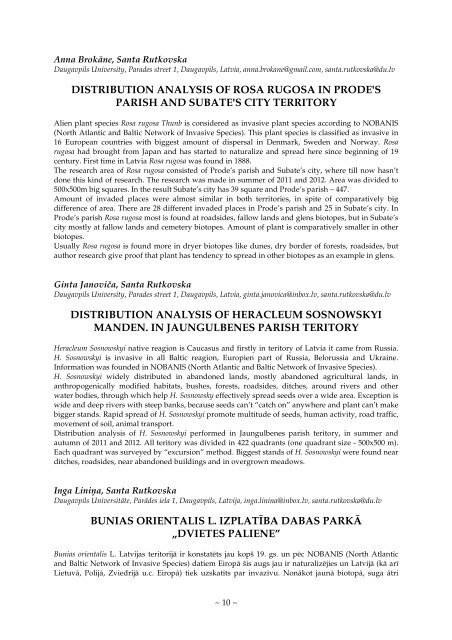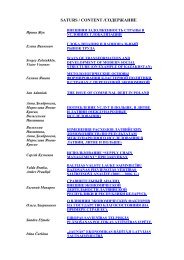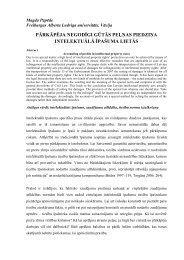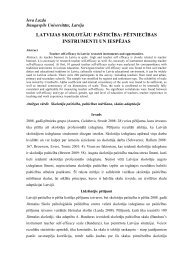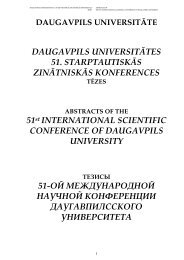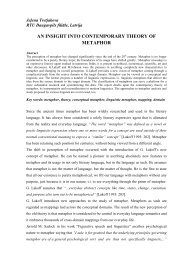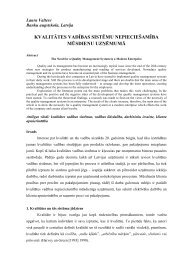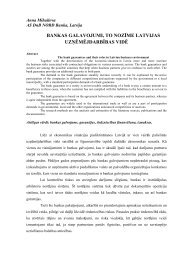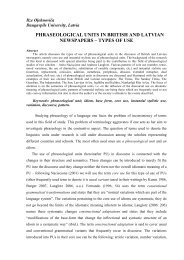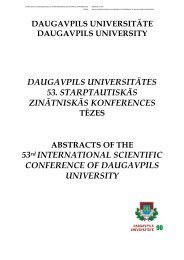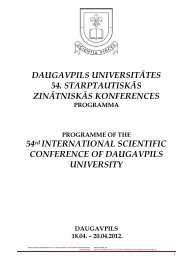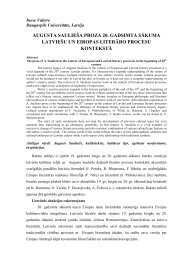Anna Brokāne, Santa Rutkovska<strong>Daugavpils</strong> University, Parades street 1, <strong>Daugavpils</strong>, Latvia, anna.brokane@gmail.com, santa.rutkovska@du.lvDISTRIBUTION ANALYSIS OF ROSA RUGOSA IN PRODE'SPARISH AND SUBATE'S CITY TERRITORYAlien plant species Rosa rugosa Thunb is considered as invasive plant species according to NOBANIS(North Atlantic and Baltic Network of Invasive Species). This plant species is classified as invasive in16 European countries with biggest amount of dispersal in Denmark, Sweden and Norway. Rosarugosa had brought from Japan and has started to naturalize and spread here since beginning of 19century. First time in Latvia Rosa rugosa was found in 1888.The research area of Rosa rugosa consisted of Prode’s parish and Subate’s city, where till now hasn’tdone this kind of research. The research was made in summer of 2011 and 2012. Area was divided to500x500m big squares. In the result Subate’s city has 39 square and Prode’s parish – 447.Amount of invaded places were almost similar in both territories, in spite of comparatively bigdifference of area. There are 28 different invaded places in Prode’s parish and 25 in Subate’s city. InProde’s parish Rosa rugosa most is found at roadsides, fallow lands and glens biotopes, but in Subate’scity mostly at fallow lands and cemetery biotopes. Amount of plant is comparatively smaller in otherbiotopes.Usually Rosa rugosa is found more in dryer biotopes like dunes, dry border of forests, roadsides, butauthor research give proof that plant has tendency to spread in other biotopes as an example in glens.Ginta Janoviča, Santa Rutkovska<strong>Daugavpils</strong> University, Parades street 1, <strong>Daugavpils</strong>, Latvia, ginta.janovica@inbox.lv, santa.rutkovska@du.lvDISTRIBUTION ANALYSIS OF HERACLEUM SOSNOWSKYIMANDEN. IN JAUNGULBENES PARISH TERITORYHeracleum Sosnowskyi native reagion is Caucasus and firstly in teritory of Latvia it came from Russia.H. Sosnowskyi is invasive in all Baltic reagion, Europien part of Russia, Belorussia and Ukraine.Information was founded in NOBANIS (North Atlantic and Baltic Network of Invasive Species).H. Sosnowskyi widely distributed in abandoned lands, mostly abandoned agricultural lands, inanthropogenically modified habitats, bushes, forests, roadsides, ditches, around rivers and otherwater bodies, through which help H. Sosnowsky effectively spread seeds over a wide area. Exception iswide and deep rivers with steep banks, because seeds can’t “catch on” anywhere and plant can’t makebigger stands. Rapid spread of H. Sosnowskyi promote multitude of seeds, human activity, road traffic,movement of soil, animal transport.Distribution analysis of H. Sosnowskyi performed in Jaungulbenes parish teritory, in summer andautumn of 2011 and 2012. All teritory was divided in 422 quadrants (one quadrant size - 500x500 m).Each quadrant was surveyed by “excursion” method. Biggest stands of H. Sosnowskyi were found nearditches, roadsides, near abandoned buildings and in overgrown meadows.Inga LiniĦa, Santa Rutkovska<strong>Daugavpils</strong> Universitāte, Parādes iela 1, <strong>Daugavpils</strong>, Latvija, inga.linina@inbox.lv, santa.rutkovska@du.lvBUNIAS ORIENTALIS L. IZPLATĪBA DABAS PARKĀ„DVIETES PALIENE”Bunias orientalis L. Latvijas teritorijā ir konstatēts jau kopš 19. gs. un pēc NOBANIS (North Atlanticand Baltic Network of Invasive Species) datiem Eiropā šis augs jau ir naturalizējies un Latvijā (kā arīLietuvā, Polijā, Zviedrijā u.c. Eiropā) tiek uzskatīts par invazīvu. Nonākot jaunā biotopā, suga ātri~ 10 ~
kĜūst par dominējošo un izkonkurē vietējās. Dabas parks „Dvietes paliene” ir viens no lielākajiem unvislabāk saglabātajiem dabisko palieĦu ekosistēmu paraugiem Latvijā un Eiropāun ir nepieciešamssaglabāt šī dabas parka vērtības, taču saistībā ar Bunias orientalis dabas parkā ir novērota negatīvatendence. Pētījuma veikšanai parka teritorija tika sadalīta 272 kvadrātos, katrs kvadrants 500x500 m.Bunias orientalis izplatība konstatēta 20 kvadrātos, vislielākās populācijas veidojot gar Daugavaskrastu. Suga savā izplatībā pamazām virzās arī uz dabas parka Z un sāk ieviesties arī citās parkateritorijās. ĥemot vērā šos faktorus, ir nepieciešams pievērst pastiprinātu uzmanību Bunias orientalisizplatībai un nepieciešamības gadījumā ieviest šīs sugas ierobežošanas pasākumus.Laura LočmeleUniversity of Latvia, Kronvalda bulvāris 4, Rīga, Latvia, locmele.laura.91@gmail.comSECONDARY SUCCESSION OF ALLUVIAL GRASSLANDS TOBLACK ALDER COMMUNITIES ON THE COAST OFTHE LAKE ĖĪŠEZERS (LATVIA)Keywords: Alnus glutinosa, alluvial meadow, secondary succession, spatial structure of vegetation.In recent years wide territories of open landscapes transform into woodlands due to changes of landuse. In floodplain of the Lake Ėīšezers wet and semi-wet grasslands turn into black aldercommunities, thus completely changing structure of lakeshore vegetation. The aim of the research wasto investigate this succession process, in order to recommend best management activities for alluvialhabitats.The field sampling was carried out during vegetation season of 2011 and 2012 in the Nature ReserveJaunciems, which is located on the coast of the Lake Ėīšezers. Four black alder patches of different agewere selected. Within each patch located sample plot (15m x 10m) was divided into 6 small plots(5m x 5m). Tree diameter, age, vitality, woodland spatial structure, plant species composition andcover (%) was characterized. For data analyses detrended correspondence analysis (DCA) wasapplied.Results show that there is a difference in spatial and age structure between various alder patches. Itchanges from young (about 5 years old trees) and very dense stands to older (about 20 years old) andmuch more sparser alderwoods. Proportions of dead trees varied from 25% to 38, 5%. The proportion ofdead treeswashighestin middle-age tree stand, due to strong competition among black alders.The ordination of small plots and species shows, that vegetation structure becomes more complex andfloristic diversity gets higher with the growth of alder patch age. For example, Shannon’s index inyoungest patch was only 0.76, but in oldest patch it was 2.99 (number of species changes from 13 to41). There are also some differences in vertical structure of various patches, from two layer structurein youngest alder patch to five in oldest one. Results of this research suggest that 20 years old blackalder patch is reached typical conditions of swamp woods (mosaic vegetation structure, diagnosticplant species composition and well executed layer structure).Lauma VizuleUniversity of Latvia, Alberta street 10, Riga, Latvia, vizule.lauma@inbox.lvCHARACTERIZATION OF MACROPHYTE VEGETATION ANDECOLOGICAL QUALITY ASSESSMENT OF THE GAREZERI LAKESKeywords: Garezeri Lakes, macrophyte species composition and occurrence, diversity indices,ecological quality.According to the Water Framework Directive 2000/60/EC all water bodies in Latvia must achieve atleast good water ecological quality status until 2015. The aim of the research “Characterization ofmacrophyte vegetation and ecological quality assessment of the Garezeri lakes” is to estimateecological quality of the Garezeri lakes by using macrophytes as biological indicators. Aquatic~ 11 ~
- Page 1 and 2: DAUGAVPILS UNIVERSITĀTEDAUGAVPILS
- Page 3 and 4: PROGRAMME COMMITTEE OFTHE 55 th INT
- Page 5 and 6: BOTĀNIKA UN DENDROLOĂIJA≈BOTANY
- Page 7 and 8: een applied relevant genetic algori
- Page 9: Pārrobežu sadarbības projekta Gr
- Page 13 and 14: ĂENĒTIKA UN BIOTEHNOLOĂIJAS≈GE
- Page 15 and 16: method, that can be used for Cotone
- Page 17 and 18: were used for PCR amplification; th
- Page 19 and 20: Anna Batjuka, Aleksandrs Petjukevi
- Page 21 and 22: pielietotām metodēm (tādām kā
- Page 23 and 24: The research was done in eight calc
- Page 25 and 26: Kaljo VoolmaEstonian University of
- Page 27 and 28: lot significant relationships betwe
- Page 29 and 30: gram - l.p.g.) was determined. The
- Page 31 and 32: Abās vecuma grupās prevalēja vid
- Page 33 and 34: Alīna Šilvāne, Anita Vētra, Evi
- Page 35 and 36: Leikocitārās formulas noteikšana
- Page 37 and 38: līvumam un attīstīt mikrorajonu
- Page 39 and 40: lokos. Pēc absolūtā augstuma iep
- Page 41 and 42: also in geoarchaeology where the st
- Page 43 and 44: 2007.gada 23.oktobra Direktīvas 20
- Page 45 and 46: JeĜena Grigorjeva, Juris SomsDauga
- Page 47 and 48: tā augstums pārsniedz 3,7 m, plat
- Page 49 and 50: Vladislavs SardikoDaugavpils Univer
- Page 51 and 52: pētījumu virzienu sauc par dendro
- Page 53 and 54: IEKŠĒJO ŪDEĥU RESURSI UN VIDES
- Page 55 and 56: Andrejs Zubaničs, Elga ApsīteLatv
- Page 57 and 58: Sarmīte SpīėeDaugavpils Universi
- Page 59 and 60: septembrī, 2012. gada 18. jūnijā
- Page 61 and 62:
Jānis Sniėeris 1 ,Velga Akmene 1
- Page 63 and 64:
Irēna Mihailova 1 , Vjačeslavs Ge
- Page 65 and 66:
MATEMĀTIKA≈MATHEMATICSSalvis Spe
- Page 67 and 68:
Anita KiričukaDaugavpils Universit
- Page 69 and 70:
Jūlija SivahoDaugavpils Universit
- Page 71 and 72:
elektronisko sistēmu arī vieglo t
- Page 73 and 74:
Evita VingreDaugavpils Universitāt
- Page 75 and 76:
avoids the harmonization of the pro
- Page 77 and 78:
kādā veidā liedzis iespēju nov
- Page 79 and 80:
kritēriju valodas paveidu lietoša
- Page 81 and 82:
CIVILTIESĪBAS≈CIVIL RIGHTSMarta
- Page 83 and 84:
Marta StepnowskaThe John Paul II Ca
- Page 85 and 86:
Nikolajs JefimovsDaugavpils Univers
- Page 87 and 88:
Александр БайковДа
- Page 89 and 90:
Ne mazāk aktuāli šobrīd ir gad
- Page 91 and 92:
Pēteris DedelisIeslodzījuma vietu
- Page 93 and 94:
Jurijs Mašošins, Jelena GruznovaD
- Page 95 and 96:
traucējumus. Šādai metodikai bū
- Page 97 and 98:
Līga MirlinaBiznesa Augstskola “
- Page 99 and 100:
Anastasija IvanovaDaugavpils Univer
- Page 101 and 102:
Jānis KudiĦšDaugavpils Universit
- Page 103 and 104:
izmaiĦas. Strukturālās izmaiĦas
- Page 105 and 106:
Diāna Vanaga, Ilona KuĦickaDaugav
- Page 107 and 108:
Reăionālās attīstības jautāju
- Page 109 and 110:
Līga Vovere¹, Veronika Buăina²
- Page 111 and 112:
UZĥĒMĒJDARBĪBAS ATTĪSTĪBA UN
- Page 113 and 114:
Pāvels LindemanisRīgas Tehniskā
- Page 115 and 116:
Aleksejs BogdaĦecsNovikontas Marit
- Page 117 and 118:
Novērots, ka vidējā svērtā atz
- Page 119 and 120:
aptaujas turp un atpakaĜ tulkošan
- Page 121 and 122:
Pētījuma mērėis: pētīt jaunie
- Page 123 and 124:
aksturo 3 laikā stabili parametri:
- Page 125 and 126:
group (equal number of males and fe
- Page 127 and 128:
Pētījumā piedalījās 40 pedagog
- Page 129 and 130:
Vineta KornejevaDaugavpils Universi
- Page 131 and 132:
Marija VasalauskieneDaugavpils Univ
- Page 133 and 134:
PEDAGOĂIJA: PĒTĪJUMI UN INOVĀCI
- Page 135 and 136:
Aija StudenteRīgas Pedagoăijas un
- Page 137 and 138:
Lai izpētītu situāciju Latvijas
- Page 139 and 140:
lietderīgai. Korektai un adekvāta
- Page 141 and 142:
Terēza LandraUniversity of Latvia,
- Page 143 and 144:
sadarbības organizēšanā. Šādu
- Page 145 and 146:
competencies). As the result, the a
- Page 147 and 148:
Aivars BulisDaugavpils Universitāt
- Page 149 and 150:
gars, ir svarīgi, lai viĦam nebū
- Page 151 and 152:
Jevgenija Mackeviča, Irina Kazakev
- Page 153 and 154:
VĒSTURES DAŽĀDĀS DIMENSIJAS:KUL
- Page 155 and 156:
Zane ButlereDaugavpils University,
- Page 157 and 158:
atspoguĜots katoĜu garīdznieku d
- Page 159 and 160:
Natalja PrilenskaDaugavpils Univers
- Page 161 and 162:
tradīcija tiek pārĦemta transfor
- Page 163 and 164:
komponentam raksturīga īpaša pra
- Page 165 and 166:
dominante ir aktualizēts hronoloă
- Page 167 and 168:
Savās pasakās Mērike izmanto vā
- Page 169 and 170:
Inesa AntonovaDaugavpils University
- Page 171 and 172:
Дина АзереДаугавпи
- Page 173 and 174:
Following Celtic and Irish folklore
- Page 175 and 176:
Ilona ěahaDaugavpils University, V
- Page 177 and 178:
Vineta RūtenbergaLatvia University
- Page 179 and 180:
Inesa AntonovaDaugavpils University
- Page 181 and 182:
этого страдавший б
- Page 183 and 184:
Daiga Vasiljeva, Ilze VolonteDaugav
- Page 185 and 186:
Agnese PavlovaDaugavpils Universit
- Page 187 and 188:
Ilmārs DirveiksDaugavpils Universi
- Page 189 and 190:
kas attiecas uz sociāliem, politis
- Page 191 and 192:
mūzikas kultūras tradīciju, sist
- Page 193 and 194:
Raksta noformēšanas paraugs:KVALI
- Page 195 and 196:
Sample:IMPROVEMENT OF QUALITATIVE R
- Page 197:
ZVIEDRU FILOLOĂIJA: PĒTĪJUMI, AK


